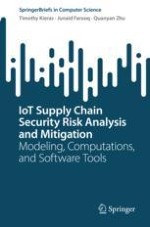2022 | OriginalPaper | Chapter
2. Risk Modeling and Analysis
Authors : Tim Kieras, Junaid Farooq, Quanyan Zhu
Published in: IoT Supply Chain Security Risk Analysis and Mitigation
Publisher: Springer International Publishing
Activate our intelligent search to find suitable subject content or patents.
Select sections of text to find matching patents with Artificial Intelligence. powered by
Select sections of text to find additional relevant content using AI-assisted search. powered by
